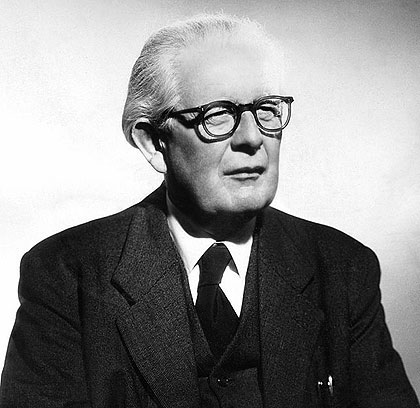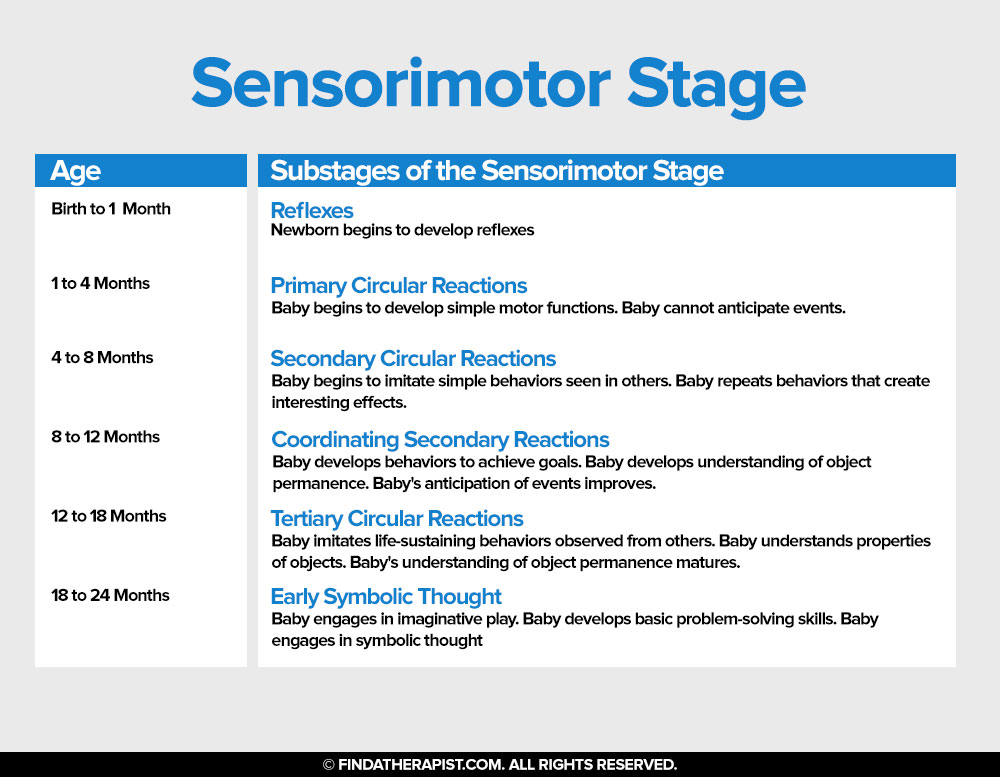Sensorimotor Stage
Published on February 19th, 2020
Updated on January 2nd, 2024

Contents
The sensorimotor stage is the first stage to Jean Piaget’s theory of cognitive development. Jean Piaget was a psychologist who studied child development. His theory on cognitive development is among the most influential theories of his professional career.

Jean Piaget’s theory of cognitive development consists of a total of four stages:
Sponsored by

Choose a therapist to work with and start healing with 20% off from BetterHelp.
Click Here- Sensorimotor Stage
- Preoperational Stage
- Concrete Stage
- Formal Operational Stage
This first stage in Piaget’s theory affects infants up to 2 years old. In their first 2 years of life, babies and toddlers learn primarily through using their senses. They learn about their environment and how to solve problems through the method of trial and error. Motor function is also developed in the sensorimotor stage.
Substages of the Sensorimotor Stage
The sensorimotor stage is divided into 6 substages that are completed at different ages in the infant’s development. During these substages, the infant progresses by learning about:
- Cause and effect
- Problem solving skills
- Object permanence
- Develop of reflexes
- Motor functions
The following are the six substages of the sensorimotor stage:
1. Reflexes
The development and exercising of reflexes begins at birth and occurs within the first month of life. The infant learns about their environment through looking at environment and sucking on objects. During this substage, the repetition of reflexes causes the infant’s movements to become more dynamic. The repetition and development of reflexes leads to more complex behaviors.
2. Primary Circular Reactions
The primary circular reactions substage occurs during 1 and 4 months old. During these months, an infant begins to engage in behaviors that are pleasurable. They learn how to generate different sensations and how to repeat behaviors that they enjoy.
Example: A child may begin to suck their thumb to generate comfort and pleasure during this substage.
Schemas
An infant begins to utilize schemas during the primary circular reactions substage. A schema is a method of interpreting and understanding information.
In child development, a schema is created through repeated behaviors and actions. With repetition, the child creates meaning behind the action.
Schemas are used to represent the meanings for different aspects of the environment. Through the development of schemas, the infant develops an understanding of the environment and how to respond to different environmental situations.
3. Secondary Circular Reactions
Between 4 and 8 months old, an infant begins to interact with the environment. They are no longer just looking at what is happening, they begin to use their other senses to learn about the environment.
In the secondary circular reactions substage, the infant may grasp objects, make noises and imitate behaviors they see. They begin to use their sight and hearing to take in and interpret information. The child learns how to use actions to elicit a response while in this stage.
Example: A child in the secondary circular reactions substage will shake a rattle to cause the noise in response.
4. Coordinating Secondary Reactions
The coordinating secondary reactions substage occurs between 8 and 12 months old. During this substage, the infant begins to use their learned schemas and behaviors to achieve goals. There is now intention behind behaviors and actions.
This substage also marks the point in which the infant begins to explore their environment independently. They may begin to crawl, grab, throw, drop or push toys and objects with intention.
Infants in this stage can apply their thoughts to their behaviors. They coordinate patterns of movement to accomplish a goal. The infant may begin to notice qualities of different objects.
Example: The child may understand that shaking a rattle will cause a sound. They will also understand that shaking a spoon will not create a sound.
5. Tertiary Circular Reactions
Tertiary circular reactions is a substage that occurs between 12 and 18 months old. During this stage, the toddler will begin to learn through trial and error. They will begin to experiment with different behaviors to see the reaction. In this stage, the toddler will repeat behaviors to find a repeated behavior in response.
Example: A child may drop a spoon from their high chair to see if mom will pick it up. If the mother picks up the spoon 4 times, but does not return it on the fifth time, the child may become upset, as the spoon did not complete the learned expected response.
In this stage of trial and error, the child learns how to apply their behavior to elicit a response. A child may learn that crying gets mom’s attention, so they cry when they want mom’s attention.
6. Early Symbolic Thought
Between 18 and 24 months, the toddler transitions into the substage, early symbolic thought. During this stage, the toddler begins to develop symbols for situations and objects. They begin to develop an understanding of the world that goes beyond their own interaction with their environment.
In this stage, the child begins to exhibit symbolic memory, as they recall symbols from their past impressions with the environment. With the symbolic memory comes the development of basic vocabulary. They engage in imaginative play and are able to use their vocabulary form simple commands and requests, like “up”.

Object Permanence
Object permanence is a critical milestone of the sensorimotor stage of development. The concept of object permanence refers to understanding that an object does not disappear from existence if it is removed from the toddler’s line of sight. Typically, a child will begin to develop object permanence between 4 and 8 months old.
Example: Just because Bailey, the family dog, left the room, does not mean he no longer exists.
Before a toddler achieves object permanence, they do not understand that an object still exists if it cannot be seen. They will forget about objects that are removed from their line of sight. Once the toddler gains awareness of object permanence, they will understand that the object still exists, but is not in their line of sight. As a result, the child may begin to look for the object, or ask for the object by using their words.
Object permanence can also be illustrated through imaginative play. They can recall objects that exist but are not present. This can be seen in a toddler feeding her doll with an empty spoon or petting a pretend cat.
Sponsored by

Find an affordable therapist online with 20% off from BetterHelp.
Click Here






Leave A Reply